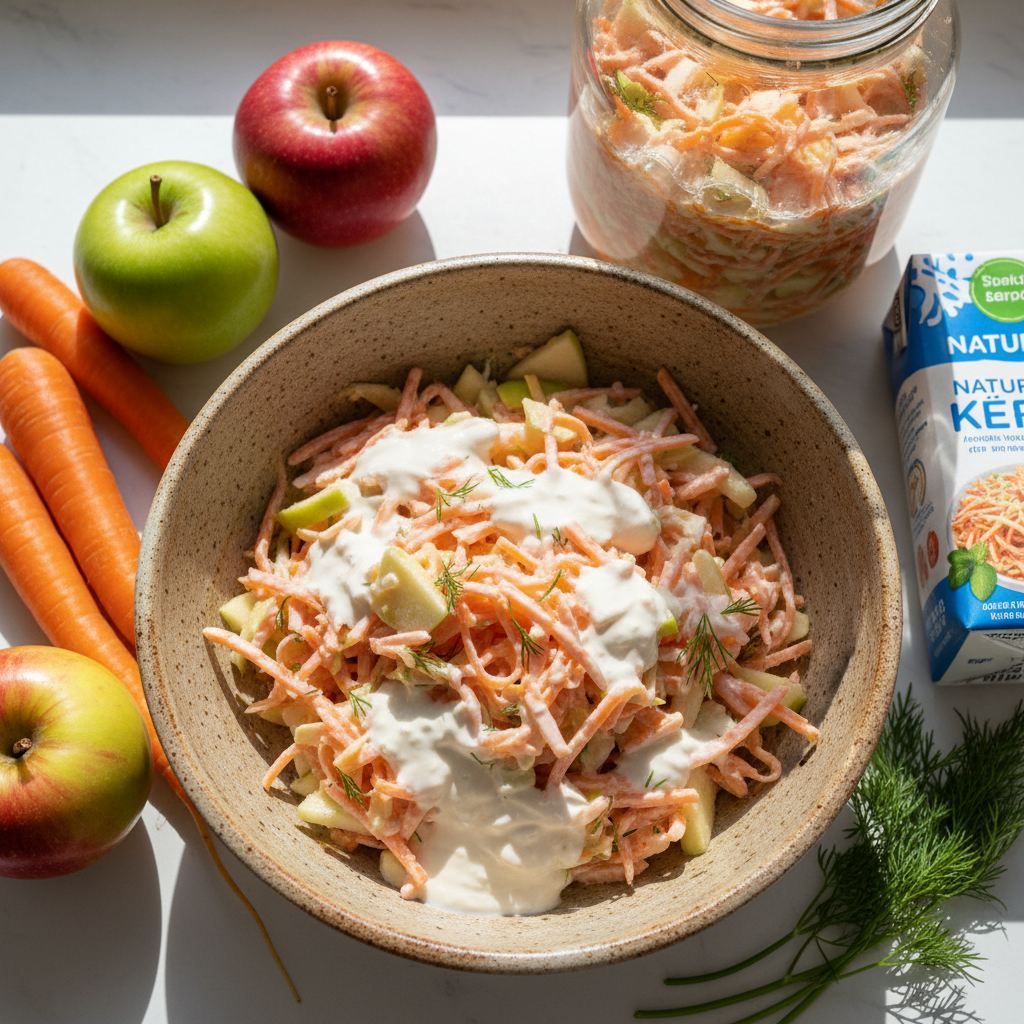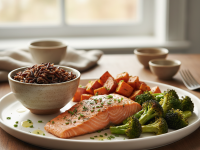Hey there, fellow food adventurer! Have you ever felt that little rumble in your tummy, hinting that maybe your gut could use a bit more love? Or perhaps you’re just curious about the vibrant world of fermented foods and their incredible health benefits? Well, you’ve landed in the right spot today, because we’re about to embark on a culinary journey that’s both deliciously satisfying and incredibly good for your insides.
Today, we’re diving headfirst into creating a mouth-watering, gut-friendly fermented carrot and apple slaw, complete with a luscious, creamy kefir dressing. Trust me when I say, this isn’t just another side dish; it’s a vibrant explosion of flavor, texture, and beneficial probiotics that will make your gut sing with joy. And the best part? It’s surprisingly easy to make, even if you’re a complete fermentatioewbie. I’ve been experimenting with fermented foods for years, and this recipe has become a staple in my kitchen for its simplicity, fantastic taste, and undeniable health perks.
Why Your Gut Deserves a Little Love (and Fermentation!)
Before we get our hands dirty (in the best way possible!), let’s chat for a moment about why focusing on gut health is such a big deal. You see, your gut is home to trillions of bacteria, both good and bad, collectively known as your gut microbiome. This tiny universe plays a massive role in everything from your digestion and nutrient absorption to your immune system, mood, and even skin health. When the balance tips towards the “bad” bacteria, that’s when you might start feeling sluggish, bloated, or generally unwell.
Enter fermented foods! These ancient powerhouses have been around for centuries, long before science caught up to explain their magic. Fermentation is essentially a controlled process where beneficial microorganisms (like lactic acid bacteria) transform food components, creating new flavors and, crucially, increasing their nutritional value and probiotic content. By regularly incorporating fermented foods like our slaw into your diet, you’re essentially replenishing and diversifying the “good” bacteria in your gut, helping to restore balance and boost overall well-being. It’s like sending tiny, helpful superheroes straight to your digestive system!
The Superstars of Our Slaw: Carrots, Apples, and the Marvel of Kefir
Each ingredient in this slaw isn’t just there for flavor; it’s a nutritional powerhouse contributing to your health.
Carrots: The Crunchy Prebiotic Heroes
Carrots are more than just a vibrant crunch. They’re packed with fiber, particularly soluble fiber, which acts as a fantastic prebiotic. Prebiotics are essentially food for your beneficial gut bacteria, helping them thrive and multiply. Plus, they offer a good dose of vitamins A and K, and antioxidants. When fermented, their natural sugars are consumed by the bacteria, making them even more gut-friendly.
Apples: Sweetness, Fiber, and Pectin
Apples bring a lovely sweetness and another dose of dietary fiber to the party. They’re especially rich in pectin, a type of soluble fiber that has well-documented prebiotic effects. Pectin can ferment in the colon, producing short-chain fatty acids that nourish gut cells and have anti-inflammatory properties. Using firm apples like Gray Smith or Honeycrisp provides a delightful contrast in texture and flavor.
Kefir: The Probiotic Champion
Our creamy dressing features kefir, a fermented milk drink that’s often described as a “superfood” for the gut. Kefir is teeming with a diverse range of beneficial bacteria and yeasts, far more diverse than many yogurts. This rich probiotic profile is what makes kefir such an excellent choice for improving digestion, boosting immunity, and even potentially helping with lactose intolerance. Its tangy, slightly effervescent flavor is absolutely perfect for a refreshing slaw dressing.
Getting Started: What You’ll Need
No fancy equipment required, just a few kitchen basics and a clean jar!
For the Fermented Slaw:
- 3-4 medium carrots, shredded (about 4-5 cups)
- 2 medium firm apples (e.g., Gray Smith, Honeycrisp), shredded or finely julieed (about 2-3 cups)
- 1.5 tablespoons non-iodized sea salt (essential for fermentation!)
- Optional: 1 teaspoon caraway seeds or a pinch of red pepper flakes for extra flavor
- A clean, wide-mouth quart-sized (1-liter) caing jar with a lid
For the Creamy Kefir Dressing:
- 1/2 cup plain whole milk kefir
- 2 tablespoons extra virgin olive oil
- 1 tablespoon fresh lemon juice
- 1 tablespoon finely chopped fresh dill or parsley (or a mix!)
- 1/2 teaspoon honey or maple syrup (optional, for a touch of sweetness)
- Salt and freshly ground black pepper to taste
Crafting Your Fermented Slaw: A Step-by-Step Adventure
This is where the magic truly begins! Don’t be intimidated; it’s more about gentle encouragement than precise scientific measurements.
Step 1: Prep Your Veggies and Fruit
First things first, wash your carrots and apples thoroughly. You can peel the carrots if you prefer, but I often leave the skins on for extra fiber and nutrients – just make sure they’re super clean. Shred the carrots and apples using a box grater, a food processor with a shredding attachment, or even a sharp knife if you’re feeling ambitious with your julieing skills. Place them in a large, clean mixing bowl.
Step 2: The Salting & Massaging Dance
Now, sprinkle the non-iodized sea salt evenly over the shredded carrots and apples. If you’re using caraway seeds or pepper flakes, add them now too. Here’s the fun part: get your hands in there! Seriously, wash them well, then start massaging and squeezing the mixture vigorously for about 5-10 minutes. You’ll notice the vegetables start to soften and release a lot of liquid. This is exactly what we want! The salt draws out water from the cells, creating the brine necessary for fermentation and inhibiting unwanted bacteria. Keep going until you have a good puddle of liquid at the bottom of the bowl.
Step 3: Pack It Tight!
Once you have a decent amount of brine, start packing the slaw mixture *very tightly* into your clean quart jar. Use your fist or a sturdy wooden spoon to press down firmly, eliminating any air pockets. The goal is to get all the shredded carrots and apples submerged under the brine. This is crucial for anaerobic fermentation (without oxygen), which encourages the good bacteria to thrive and prevents mold.
If, after packing, the vegetables aren’t fully submerged, you can make a small supplemental brine: dissolve 1 teaspoon of sea salt in 1 cup of filtered water, and add just enough to cover the vegetables. Leave about an inch of headspace from the top of the jar.
Step 4: The Waiting Game (aka Fermentation)
Seal your jar with a lid (you can use a regular lid, or a fermentation airlock lid if you have one – it just makes things a bit easier). Place the jar in a cool, dark spot in your kitchen, away from direct sunlight. Now, for the hard part: waiting! The fermentation time can vary depending on your ambient temperature and how tangy you like your slaw. Generally, it takes anywhere from 3 to 7 days.
Check on your slaw daily. You might see small bubbles forming – that’s a good sign! It means the beneficial bacteria are actively working. Taste a small bit after 3 days. If it’s tangy enough for your liking, it’s ready! If you want it more sour, let it ferment for a few more days. Once it reaches your preferred tanginess, transfer the jar to the refrigerator. This will slow down the fermentation process significantly, and your fermented slaw will keep well for several weeks (or even months!).
Whipping Up the Dreamy Kefir Dressing
While your slaw is fermenting, or just before you’re ready to serve, you can whip up this super simple, yet incredibly flavorful dressing.
In a small bowl, whisk together the plain kefir, extra virgin olive oil, fresh lemon juice, chopped dill (or parsley), and a tiny drizzle of honey or maple syrup if you like a hint of sweetness. Season with salt and freshly ground black pepper to taste. Taste and adjust as needed – maybe a little more lemon for zing, or more dill for herbaceousness. That’s it! This dressing is so versatile, you might find yourself putting it on everything.
Bringing It All Together: Serving Suggestions & Variations
Once your fermented slaw is ready, drain off any excess brine (you can save it to kickstart your next ferment!). In a medium bowl, combine your desired amount of fermented carrot and apple slaw with a generous dollop of the creamy kefir dressing. Toss gently to coat.
Serving Suggestions:
- As a vibrant side dish to grilled chicken, fish, or plant-based burgers.
- Piled high on sandwiches, wraps, or tacos for an added crunch and tang.
- Mixed into a green salad for an extra layer of flavor and probiotic boost.
- A refreshing accompaniment to rich stews or hearty main courses.
- Honestly, sometimes I just eat it straight from the bowl as a healthy snack!
Variations to Experiment With:
- Spice It Up: Add a pinch of turmeric or grated fresh ginger to the slaw mixture before fermenting for extra warmth and anti-inflammatory benefits.
- Herbaceous Twist: Experiment with different fresh herbs in the dressing – chives, mint, or cilantro could all be delicious.
- Nutty Crunch: Sprinkle some toasted sunflower seeds or walnuts on top just before serving for added texture.
- Sweet & Savory: A handful of dried cranberries or golden raisins (added after fermentation) can add a delightful chewiness and extra sweetness.
Troubleshooting & Tips for Fermentatioewbies
Don’t worry if your first ferment isn’t “perfect.” It’s a learning process!
- Mold: If you see any fuzzy, colored mold (black, green, pink), unfortunately, you’ll need to discard the batch. This usually happens if the vegetables aren’t fully submerged in brine or if there’s too much air exposure.
- Scum/Kahm Yeast: A white, often wrinkly film on the surface (not fuzzy) is usually kahm yeast, which is harmless but can impart an off-flavor. You can usually just skim it off.
- Soft Texture: If your slaw is too soft, it might have fermented too long, or your ingredients weren’t as firm to begin with. It’s still safe to eat, just less crunchy.
- Smell Test: A healthy ferment should smell pleasantly sour, tangy, and a bit like pickles. If it smells foul, rotten, or like alcohol, it’s best to discard it.
Your Gut’s Happy Place Awaits!
Making your own fermented foods is such a rewarding experience. There’s something incredibly satisfying about transforming simple ingredients into something so vibrant, flavorful, and profoundly good for you. This fermented carrot and apple slaw with creamy kefir dressing isn’t just a recipe; it’s an invitation to nourish your body from the inside out, explore new flavors, and embrace a healthier, happier gut.
So, why not give it a try this week? Your taste buds will thank you, and more importantly, your gut will send you a heartfelt thank you note. Happy fermenting!




